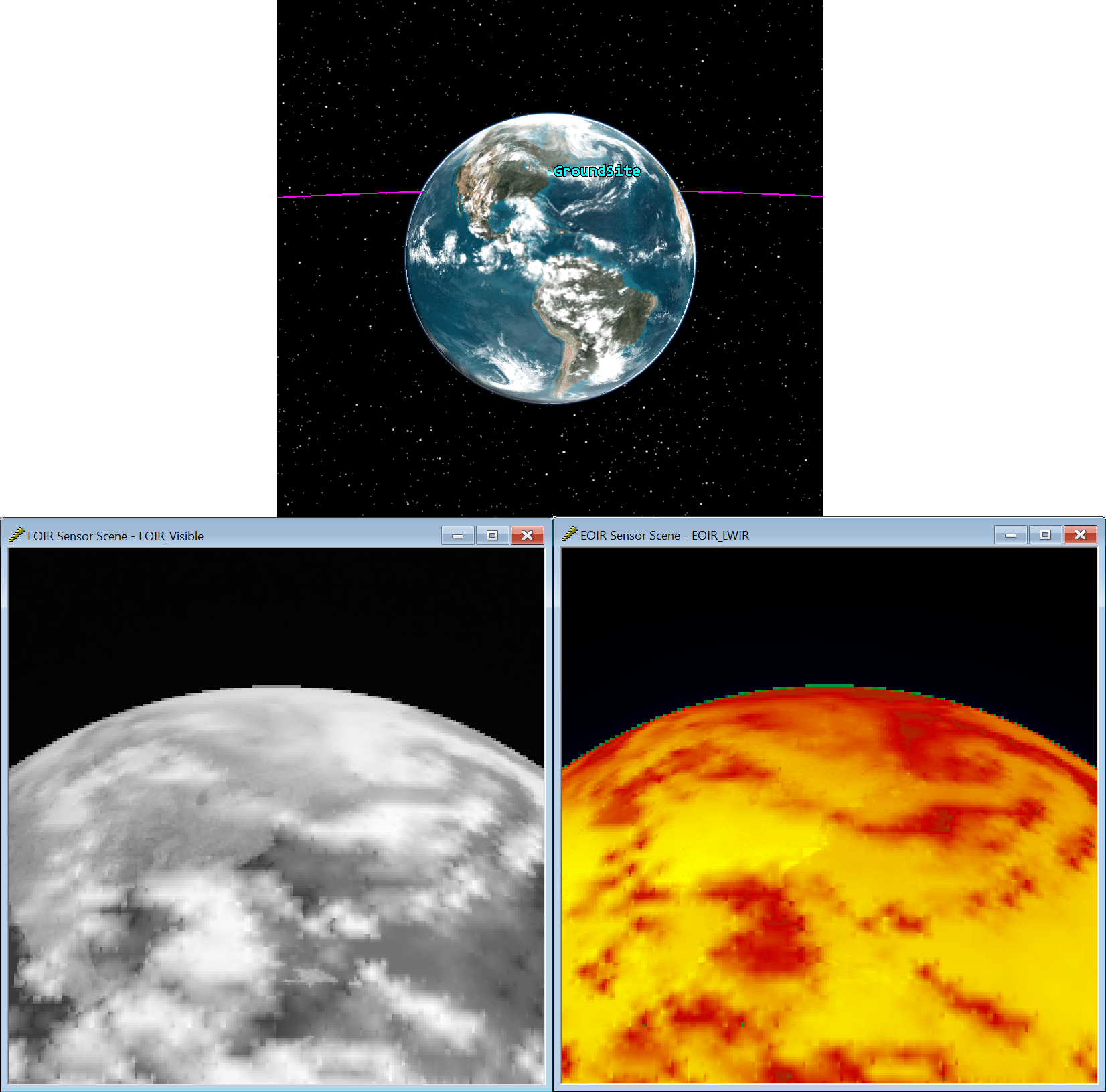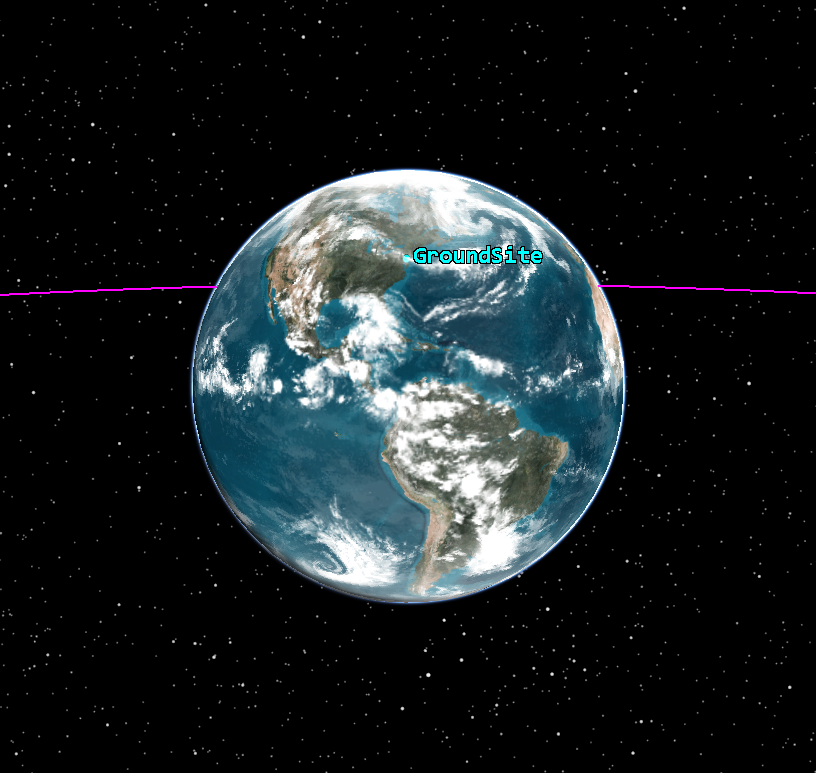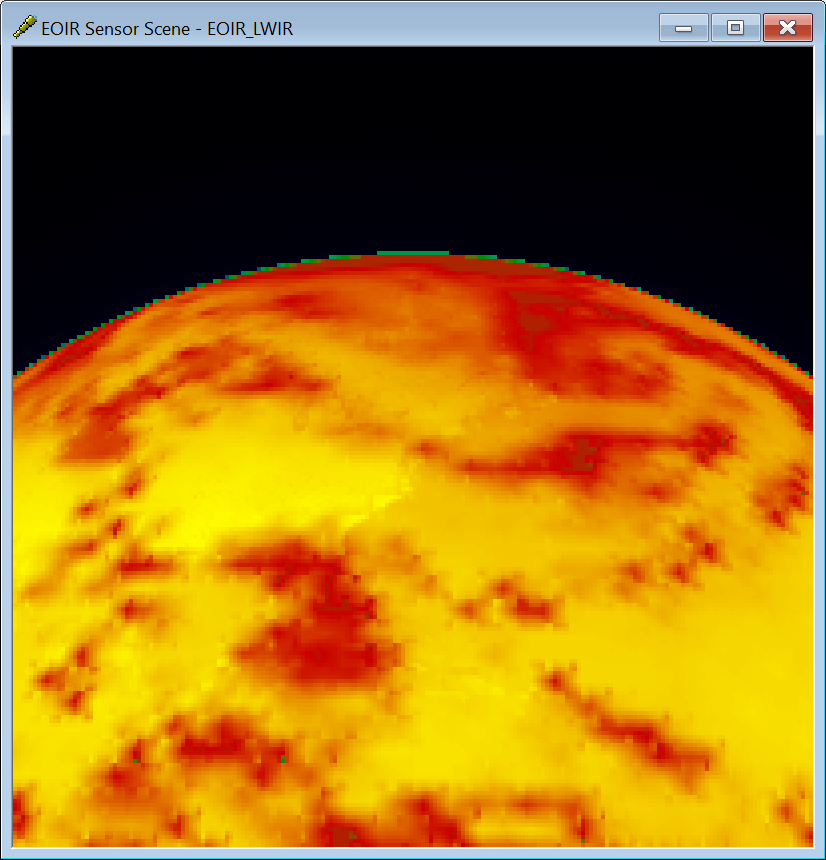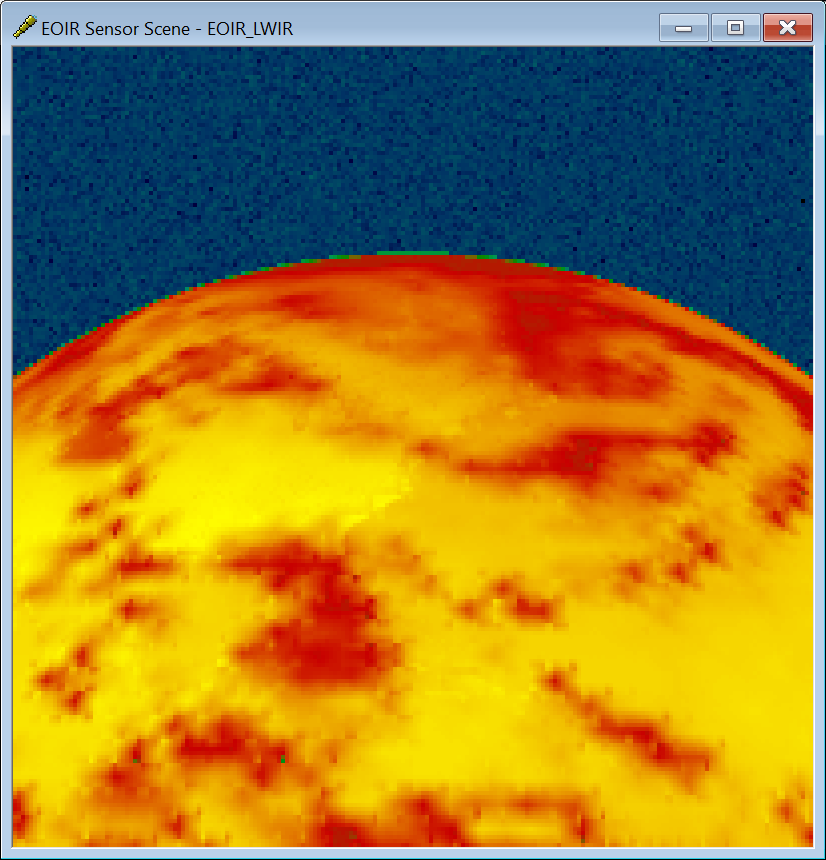STK Premium (Air), STK Premium (Space), or STK Enterprise
You can obtain the necessary licenses for this tutorial by contacting AGI Support at support@agi.com or 1-800-924-7244.
Required Capability Install: For versions 12.10 and earlier of the STK software, this lesson requires the installation of the EOIR capability. For these versions of the software, the EOIR installer is included in the STK Premium software download, but requires a separate installation process. Read the Readme.htm found in the STK software install folder for installation instructions. You can obtain the necessary install by visiting https://support.agi.com/downloads or calling AGI support.
The results of the tutorial may vary depending on the user settings and data enabled (online operations, terrain server, dynamic Earth data, etc.). It is acceptable to have different results.
Capabilities covered
This lesson covers the following STK Capabilities:
- STK Pro
- Electro-Optical Infrared Sensor Performance (EOIR)
Problem statement
Determining when a system can detect, track, identify, and characterize targets of interest under operational conditions is critical to the success of a mission. Modeling and simulating these operations with a set of disparate tools can take far too long and is prone to mistakes. You need a single, multidomain analysis platform to accelerate your work.
Solution
STK's EOIR capability models the detection, tracking, and imaging performance of Electro-Optical Infrared (EOIR) sensors for Earth science, space situational awareness, and missile defense applications. Results support concept design, engineering, test, and operations.
With EOIR in STK 12 or newer, you can account for time-dynamic clouds—the natural enemy of all optical systems—in your mission. In this tutorial you will model a geosynchronous weather satellite and the cloud patterns it would see from orbit. You will also observe the results in the sensor data. Going forward, you can then account for potential targets becoming obscured.
Upon completion of this tutorial, you will be able to:
- Design a space-based observation system.
- Build on board visible and long wave infrared cameras.
- Analyze sensor scenes.
The sensor specifications in this lesson are notional.

Video guidance
Watch the following video. Then follow the steps below, which incorporate the systems and missions you work on (sample inputs provided).
Getting started
You'll begin by building a scenario and then inserting the objects for this mission:
- a ground site
- a GEO sat
- a tracking sensor
Once you've established these objects, you'll add a new level to your analysis with an EOIR sensor.
-
Click the Create a Scenario (
 ) button.
) button. - Enter the following in the New Scenario Wizard:
- Click .
| Option | Value |
|---|---|
| Name | EOIR_CloudPatterns |
| Start Time | Default Start Time |
| Stop Time | Default Stop Time |
Verifying that EOIR is installed
Ensure that EOIR is installed on your computer.
- If you do not see the EOIR toolbar (
 ), extend the View menu.
), extend the View menu. - Select the Toolbars option.
- Select EOIR.
Disabling STK Terrain Server
In this analysis, you won't be utilizing streaming terrain imagery. The main asset is a space-based geosynchronous satellite. You can disable STK's Terrain Server.
- Open EOIR_CloudPatterns's (
 ) properties (
) properties ( ).
). - Browse to the Basic - Terrain page.
- Clear the Use terrain server for analysis check box.
- Click .
Inserting a Facility
When you build the space-based observation system, you can use a facility on the ground as a target to point the sensor. You do not need to set any specific parameters for the ground site.
- Insert a Facility (
 ) object using the Insert Default (
) object using the Insert Default ( ) method.
) method. - Rename the facility to GroundSite.
Inserting a Satellite
Build the Earth Observation satellite.
- Insert a Satellite (
 ) object using the Orbit Wizard (
) object using the Orbit Wizard ( ) method.
) method. - Set the following options in the Orbit Wizard:
- Set the Definition parameters:
- Click .
| Option | Value |
|---|---|
| Type | Geosynchronous |
| Satellite Name | EarthObsSat |
| Show All Objects | On |
The Show All Objects helps you see where GroundSite is with respect to the satellite. Since the satellite is in GEO, as long as you are on the correct side of the hemisphere, you are able to see GroundSite.
| Option | Value |
|---|---|
| Subsatellite Point | -75 deg |
| Inclination | 0 deg |
Inserting a sensor
You are creating a space-based Earth observation system. Take a moment to insert a sensor and place it on the EarthObsSat satellite.
- Insert a Sensor (
 ) object using the Define Properties (
) object using the Define Properties ( ) method.
) method. - Select EarthObsSatellite.
- Click .
Defining the sensor properties
Be default, a sensor is mounted on a satellite pointed at the Earth. Using the targeted option, you can center the sensor's focus on GroundSite. That changes the angle of the sensor.
- Browse to the Basic - Pointing page.
- Set the Pointing Type to Targeted.
- Move (
 ) GroundSite to the Assigned Target list. This is the point of focus for the sensor.
) GroundSite to the Assigned Target list. This is the point of focus for the sensor.
Setting the EOIR settings
You defined the point behavior of the sensor. Next, you can address the Electro-Optical Infrared component of this mission.
EOIR settings - Spatial
Set the EOIR spatial parameters for the sensor.
- Select the Basic - Definition page.
- Set the Sensor Type to EOIR.
- Ensure the Spatial tab is selected and set the following options:
- Click .
| Option | Value |
|---|---|
| Input | Field-of-View and Number of Pixels |
| Field of View - Horizontal Half Angle | 5.0 deg |
| Field of View - Vertical Half Angle | 5.0 deg |
| Number of Pixels - Horizontal | 200.00 |
| Number of Pixels - Vertical | 200.00 |
EOIR settings - spectral
The spectral band wavelengths are set in the Spectral tab. This study analyzes the visible waveband (0.4-0.7 um).
- Locate the Spectral Band Edge Wavelengths field.
- Set the Low to 0.400 um.
- Set the High to 0.700 um.
- Click .
EOIR settings - Optical
You can set the Image Quality and the Optical Transmission on the Optical tab. You can set two of the optical inputs and EOIR automatically calculates the third.
- Select the Optical tab.
- Set the following options:
- Click .
| Option | Value |
|---|---|
| Input | F-Number and Entrance Pupil Diameter |
| F/# | 2.00 |
| Entrance Pupil Diameter | 100 cm (considered commercially viable) |
| Image Quality | Negligible Aberrations |
EOIR settings - radiometric
On the radiometric tab, you can set the values that define the radiant energy measurement properties. At a high level the sensitivity defines the noise floor of the sensor. After generating the sensor scene, you can revisit these parameters.
- Select the Radiometric tab.
- Set the Input to High Level.
- Click .
- Rename the sensor EOIR_Visible.
Set the target object
From the EOIR Target Configuration, you can select STK objects to use in the generated sensor scene. You can add Groundsite.
- Select EOIR_Visible (
 ) in the Object Browser.
) in the Object Browser. - Click the EOIR Target Configuration (
 ) button on the EOIR toolbar.
) button on the EOIR toolbar. - Move (
 ) the Facility/GroundSite to the Selected Target list. As a reminder, there are no thermal properties defined for the ground site.
) the Facility/GroundSite to the Selected Target list. As a reminder, there are no thermal properties defined for the ground site. - Click .
- Save (
 ) the scenario.
) the scenario.
Generate a sensor scene
EOIR can create an image of what the system on the EarthObsSat sees. The current state is the Earth without any weather patterns, i.e., clouds.
- Select the EOIR_Visible (
 ) in the Object Browser.
) in the Object Browser. - In the EOIR toolbar, click the EOIR Sensor Scene (
 ) button to generate an image that represents the sensor output.
) button to generate an image that represents the sensor output. - Give STK a moment to generate the scene.
- Right-click the sensor scene and select Details...
- Set the Scene Detail to Fine. This shows a higher resolution of the Globe.
- Click .
- Close the sensor scene.

Loading the current weather patterns
With STK, you can download the most recent cloud model for the scenario. If you are working offline, there are cloud models that you can load into the scenario. Before loading in the cloud model, first review the settings of this capability in the Clouds section of the EOIR Atmosphere Model STK Help page.
Using Connect commands for EOIR
Additional parameters can be set with Connect commands (for example, adding multiple cloud layers). Below are some examples of those commands.
EOIR */ SetAtmosphere Clouds On
EOIR */ CloudData DatasetTest1 0 1000
EOIR */ CloudData NewConstDataSet Test2
EOIR */ CloudData AddCldDataSets Test3 “…\CloudData.cld”
To set any of these commands via Connect, you can use the following:
EOIR */ CloudData SetValue DataLabel ParameterName Value
Valid values for ParameterName are listed on the EOIR CloudData STK Help page.
Setting the EOIR Atmosphere model
- Click the EOIR Target Configuration (
 ) button on the EOIR toolbar.
) button on the EOIR toolbar. - Select the button.
- Left-click on the Clouds page.
- Select the Show check box for Clouds.
- Click .
- Enter SimpleClouds in the Dataset Label.
- Set the following options:
- Set the Coverage to File.
- Click .
- Keep the default Radiance or Emissivity/Temperature set to Constant Emissivity and Temperature default values.
- Click in the EOIR Atmosphere Model.
- Click in the EOIR Configuration window.
| Option | Value |
|---|---|
| Altitude | 10 km |
| Forward Scatter | 50% |
| Back Scatter | 50%. |
The downloaded clouds are in the C:\ProgramData\AGI\STK_ODTK 13\STKData\VO\Clouds
Optionally, you can load in the local cloud models by clicking on the ellipsis button and selecting a file from the STK install, typically at <Install Dir>\EOIR_Databases\Clouds.
Using Globe Manager - Cloud Model
You loaded in the Cloud model for your EOIR sensor. You can also view the clouds in the 3D Graphics window.
- Open the Globe Manager (
 ).
). - Right-click on Clouds.cld.
- Select the Change Clouds option.
- Select the Clouds.cld file.
- Click .
- Examine the clouds in the 3D Graphics window. This gives you an idea of what you will see in the EOIR sensor scene.

Generating a sensor scene
EOIR can create an image of what the system on the EarthObsSat sees. The current state is of the Earth with a cloud model loaded.
- Select the EOIR_Visible (
 ) in the Object Browser.
) in the Object Browser. - In the EOIR toolbar, click the EOIR Sensor Scene (
 ) button to generate an image that represents the sensor output.
) button to generate an image that represents the sensor output. - Give STK a moment to generate the scene.
- Close the sensor scene.

Viewing Earth observations in the long-wavelength infrared band
The first EOIR sensor just looked at the visible part of the spectrum. Look at the long-wavelength infrared (8-15um). This is the thermal imaging region or thermal infrared region of the spectrum.
- Copy (
 ) EOIR_Visible (
) EOIR_Visible ( ) in the Object Browser.
) in the Object Browser. - Paste (
 ) the sensor on EarthObsSat.
) the sensor on EarthObsSat. - Rename the sensor EOIR_LWIR.
- Open EOIR_LWIR's (
 ) properties (
) properties ( .
. - Ensure the Spectral tab is selected.
- Set the following wavelength bounds:
- Click .
- Save (
 ) the scenario.
) the scenario.
| Option | Value |
|---|---|
| High | 15.000 um |
| Low | 8.000 um |
Set the high value first to keep all values within the limits.
Generating a sensor scene
Using the new sensor, generate a new sensor scene to see the differences in the model.
- Select the EOIR_LWIR (
 ) in the Object Browser.
) in the Object Browser. - In the EOIR toolbar, click the EOIR Sensor Scene (
 ) icon to generate an image that represents the sensor output.
) icon to generate an image that represents the sensor output. - Give STK a moment to generate the scene.
- Right-click on the sensor scene and select Details...
- Set the Scene Detail to Fine. This shows a higher resolution of the Globe.
- Set the Color Map to BGRY.
- Click .

Viewing cloud inband radiance
- Click on a cloud in the sensor scene.
- In the Details panel, take a look at the Inband Radiance values, specifically the order of magnitude.
The inband Radiance order of magnitude gives you insight as to how sensitive the sensor should be. You can adjust the radiometric settings to be of the same magnitude.
Defining the sensitivity
- Bring EOIR_LWIR's (
 ) properties (
) properties ( ) to the front.
) to the front. - Select the Basic - Definition page.
- Select the Radiometric tab.
- Set the Units for Saturation and Sensitivity to Radiance.
- Enable the Simulate Saturation option.
- Set the Sensitivity - Equivalent Value to 0.00001 (1e-5). This value is found by varying the sensitivity until the sensor scene shows some noise in space, but otherwise a smoothed display.
- Set the Dynamic Range - Equivalent Value to 0.3. This value is found by varying the dynamic range.
- Click .
- Wait for the sensor scene to update.

The data from the sensor scene can be exported from the Details panel in the Automatic File Output field. You can load this data into MATLAB or your preferred tool for post-processing.